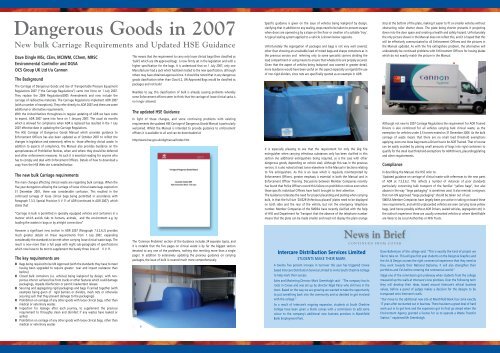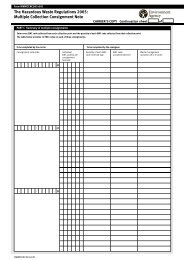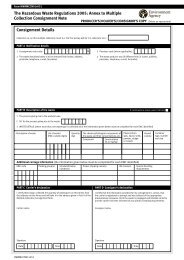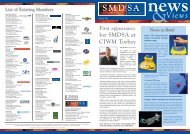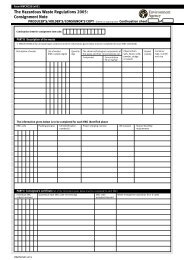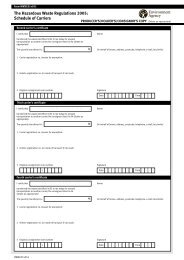&Views
Views - SMDSA
Views - SMDSA
- No tags were found...
Create successful ePaper yourself
Turn your PDF publications into a flip-book with our unique Google optimized e-Paper software.
Dangerous Goods in 2007<br />
New bulk Carriage Requirements and Updated HSE Guidance<br />
Dave Dingle MSc, CEnv, MCIWM, CChem, MRSC<br />
Environmental Controller and DGSA<br />
OCS Group UK Ltd t/a Cannon<br />
The Background<br />
The Carriage of Dangerous Goods and Use of Transportable Pressure Equipment<br />
Regulations 2007 (“‘the Carriage Regulations”) came into force on 1 July 2007.<br />
They replace the 2004 Regulations/2005 Amendments and now include the<br />
carriage of radioactive materials. The Carriage Regulations implement ADR 2007<br />
(with a number of exceptions). They refer directly to ADR 2007 and there are some<br />
additional or alternative requirements.<br />
With the United Nations throughness in regular updating of ADR we have come<br />
to expect, ADR 2007 came into force on 1 January 2007. The usual six months<br />
which is allowed for compliance when ADR is replaced has resulted in the 1 July<br />
2007 effective date in updating the Carriage Regulations.<br />
The HSE Carriage of Dangerous Goods Manual which provides guidance to<br />
Enforcement Officers has also been updated as of October 2007 to reflect the<br />
changes in legislation and extensively refers to those affecting clinical waste. In<br />
addition to aspects of compliance, the Manual also provides Guidance on the<br />
apropriateness of Prohibition Notices, when and where they should be deferred<br />
and other enforcement measures. As such it is essential reading for anyone who<br />
has to comply and deal with Enforcement Officers. Details of how to download a<br />
copy from the HSE Web site is detailed below.<br />
The new bulk Carriage requirements<br />
The main changes affecting clinical waste are regarding bulk carriage. When the<br />
five year derogation allowing the carriage of loose clinical waste bags expired on<br />
31 December 2001, there was considerable confusion. This resulted in the<br />
continued carriage of loose clinical bags being permitted in accordance with<br />
Paragraph 7.3.3, Special Provision V V 11 of ADR (continued in ADR 2007), which<br />
states that:<br />
“Carriage in bulk is permitted in specially equipped vehicles and containers in a<br />
manner which avoids risks to humans, animals, and the environment e.g. by<br />
loading the wastes in bags or by airtight connections”<br />
This means that the requirement to carry only loose clinical bags (then classified as<br />
‘bulk’) which are UN approved bags is now firmly set in the legislation and with a<br />
higher specification for the bags. It is understood that on 1 July 2007, only one<br />
Manufacturer had a sack which had been tested to the new specification, although<br />
others may have obtained approval since. It should be noted that in any dangerous<br />
goods classification other than Class 6.2, UN Approved Bags would be classified as<br />
packages and not bulk!<br />
Needless to say, this classification of bulk is already causing problems whereby<br />
some Enforcement officers seem to think that the carriage of loose clinical sacks is<br />
no longer allowed.<br />
The updated HSE Guidance<br />
In light of these changes, and some continuing problems with existing<br />
requirements the updated HSE Carriage of Dangerous Goods Manual is particularly<br />
welcomed. Whilst the Manual is intended to provide guidance to enforcement<br />
officers it is available to all and can be downloaded at<br />
http://www.hse.gov.uk/cdg/manual/index.htm<br />
Specific guidance is given on the issue of vehicles being leakproof by design,<br />
clarifying that in addition to any sealing, steps need to be taken to prevent escape<br />
when doors are opened e.g by a slope on the floor or creation of a suitable ‘tray’.<br />
A typical sealing system applied to a vehicle is shown below opposite.<br />
Unfortunately the segregation of packages and bags is not very well covered,<br />
other than showing an unsuitable load of mixed bags and sharps containers as in<br />
the previous version and referring only to some specialist carriers dividing the<br />
load compartment or using means to ensure that wheele bins are propely secured.<br />
Given that the aspect of vehicles being leakproof was covered in greater detail,<br />
more Guidance would have been useful on this aspect especially as regards the use<br />
of non-rigid dividers, since nets are specifically quoted as an example in ADR.<br />
It is especially pleasing to see that the requirement for only the 2kg fire<br />
extinguisher when carrying infectious substances only has been clarified in this<br />
section (no additional extinguishers being required, as is the case with other<br />
dangerous goods, depending on vehicle size). Although this was in the previous<br />
version, it is also noted at least twice elsewhere in the Manual in Sections relating<br />
to fire extinguishers. As this is an issue which is regularly misinterpreted by<br />
Enforcement Officers, greater emphasis is essential in both the Manual and in<br />
Enforcement Officer Training. Discussions between Member Companies recently<br />
has found that Police Officers record this failure on prohibition notices even when<br />
those specific individual Officers have had it brought to their attention.<br />
The Guidance reiterates the need for proper placarding and plating when carrying<br />
bulk, in that the full size ‘2X/3291/Infectious placard’ plates need to be displayed<br />
on both sides and the rear of the vehicle, but not the emergency telephone<br />
number. Member Companies of the SMDSA have recently clarified with the help<br />
of HSE and Department for Transport that the absence of the telephone number<br />
means that the plate can be made smaller and need not display the plain orange<br />
strip at the bottom of the plate, making it easier to fit on smaller vehicles without<br />
obstructing roller shutter doors. The plate being shorter prevents it projecting<br />
down into the door space and creating a health and safety hazard. Unfortunately<br />
the only picture shown in the Manual does not reflect this, and it is hoped that this<br />
will be effectively communicated to all Enforcement Officers and the pictures in<br />
the Manual updated. As with the fire extingishers problem, the alternative will<br />
undoubtedly be continued problems with Enforcement Officers for having plates<br />
which do not exactly match the picture in the Manual.<br />
Although not new to 2007 Carriage Regulations the requirement for ADR Trained<br />
Drivers is also reinforced for all vehicles carrying bulk clinical waste, as the<br />
exemption for vehicles under 3.5 tonnes ended on 31 December 2006. As the bulk<br />
carriage of waste means that there are no small load threshold exemptions<br />
applying, even one loose bag means a Driver has to be ADR Trained. That of course<br />
can be easily avoided by placing small amounts of bags into rigid containers to<br />
qualify for the small load threshold exemptions for ADR Drivers, placarding/plating<br />
and other requitrements.<br />
Compliance<br />
In describing the Manual, the HSE refer to:<br />
‘Updated guidance on carriage of clinical waste with references to the new parts<br />
of ADR at 7.3.2.6.2. This reflects a number of instances of poor standards<br />
particularly concerning bulk transport of the familiar “yellow bags”, but also<br />
abuses in the way “large packaging” is sometimes used. It also reminds consignors<br />
that non-UN approved “large packaging” should be taken out of use’.<br />
SMDSA Member Companies have largely been pro-active in taking on board these<br />
new requirements, and whilst unplacarded vehicles are seen carrying loose yellow<br />
bags, (and hence possibly without ADR Drivers, sealed vehicles, segregation etc) in<br />
the author’s experience these are usually unmarked vehicles or where identifiable<br />
are likely to be Local Authorities or NHS Trusts.<br />
However a significant new section in ADR 2007 (Paragraph 7.3.2.6.2) provides<br />
much greater details on these requirements from 1 July 2007, expanding<br />
considerably the standards to be met when carrying loose clinical waste bags. The<br />
result is now more than a full page with eight sub-paragraphs of specifications<br />
which now have to be met to supplement the barely three lines of V V 11.<br />
The key requirements are<br />
■ Bags being required to be UN Approved (with the standards they have to meet<br />
having been upgraded to require greater tear and impact resistance than<br />
before)<br />
■ Closed bulk containers (i.e. vehicles) being leakproof by design, with nonporous<br />
interior surfaces free from cracks or other features which could damage<br />
packagings, impede disinfection or permit inadvertent release<br />
■ Securing and segregating rigid packagings and bags if carried together (with<br />
examples being given of rigid barriers or dividers, mesh nets or otherwise<br />
securing such that they prevent damage to the packagings)<br />
■ Prohibition on carriage of any other goods with loose clinical bags, other than<br />
medical or veterinary wastes<br />
■ Inspection for leakage after each journey, to supplement the previous<br />
requirement to throughly clean and disinfect if any wastes have leaked or<br />
spilled<br />
■ Prohibition on carriage of any other goods with loose clinical bags, other than<br />
medical or veterinary wastes<br />
The ‘Common Problems’ section of the Guidance includes 24 separate topics, and<br />
it is notable that the five pages on clinical waste is by far the biggest section<br />
devoted to any one of the problems, nothing else meriting more than a single<br />
page!. In addition to extensively updating the previous guidance on carrying<br />
packages, the issue of bulk is covered much more comprehensively.<br />
Intercare Distribution Services Limited<br />
STUDENTS MAKE THEIR MARK<br />
A twenty five percent increase in turnover this year has triggered Crewe<br />
based Intercare Distribution Services Limited to invite South Cheshire College<br />
to help mark their success.<br />
Sales and Marketing Director Mark Greenhalgh said: “The company has its<br />
roots in Crewe and was set up by director Nigel Parry who still lives in the<br />
town. Based on the way we are growing we wanted to take the opportunity<br />
to put something back into the community and so decided to get involved<br />
with the college.”<br />
As a result of Intercare’s ongoing expansion, students at South Cheshire<br />
College have been given a blank canvas with a commission to add some<br />
colour to the company’s additional new business premises in Marshfield<br />
Bank Employment Park.<br />
CONTINUED FROM COVER<br />
Dave Ballentyne of the college said: “This is exactly the kind of project we<br />
like to take on. This will give first year students on the Design & Graphics and<br />
the Art & Design courses the right commercial experience that they need as<br />
they work towards their National Diplomas. It will also strengthen their<br />
portfolios and CVs before entering the commercial world.”<br />
Stage one of the commission got underway when students from the college<br />
measured up the walls at Intercare’s new premises. Over the following term<br />
they will develop their ideas, based around Intercare’s ethical business<br />
values, before a panel of judges makes a decision for the designs to be<br />
transposed onto Intercare’s walls.<br />
“Our move to the additional new site at Marshfield Bank has come exactly<br />
17 years after we started out in business. There has been a great deal of hard<br />
work put in to get here and the expansion got its final go ahead when the<br />
Environment Agency granted a license for us to operate a Waste Transfer<br />
Station,” explained Mr Greenhalgh.


